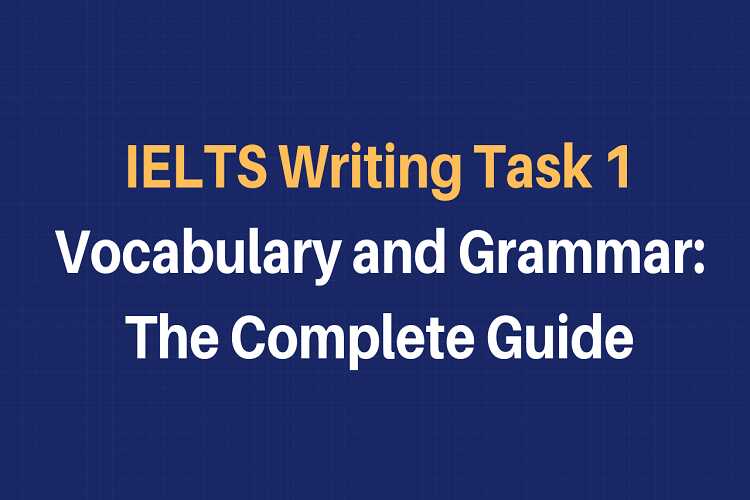Grammar and vocabulary are the dynamic duos of IELTS academic writing tasks. Every component assesses your ability to write/ speak grammatically correct sentences and to use contextual शब्दावली. In the writing task 1, grammar and vocabulary play an important role. Let us see how!
IELTS Academic Writing Task 1 Marking Criteria
As suggested by many experts, understanding the exam format and the marking criteria makes your preparation a lot easier and not to mention, organised.
In the writing task 1, you will be asked to write a letter in 150 words. It could be formal, informal or semi-formal. You shouldn’t spend more than 20 minutes writing this letter and must take care that you do not write less than 150 words.
If your word count exceeds 10-15 words, it is acceptable. However, you must not keep on writing as the second task needs more time.
The Marking Criteria are Fairly Detailed for Writing Task 1:
- व्याकरणिक सीमा और सटीकता
- कार्य उपलब्धि
- शाब्दिक साधन
- जुटना और सामंजस्य
Here you can see that grammar accounts for 25% of the marks in your IELTS writing task 1 topic. Furthermore, your grammar is assessed in two things:
- Ability to write grammatically accurate sentences.
- Ability to use a wide range of grammar structures.
Accuracy of Grammar
Examiners look for how many ‘error-free’ sentences you have written. Therefore, you need to make sure each sentence has no errors. Even a small mistake like an article in the wrong place or misplaced plural counts towards this.
As a result, it is vital that you check your work after you finish writing. Always try to leave yourself two minutes in the end to proofread your work. Simple errors, which could be fixed with a quick check, select and report or modify, will really damage your marks in this area.
Range of Grammar
A good academic writing task answer will have a range of appropriate structures and tenses. Many students try to insert complex sentences and tenses into their answers. This isn’t a good strategy. It will make your answers look unnatural and can result in you making mistakes.
A good answer uses complex sentences (such as conditional and relative clauses) that flow naturally.
Grammar for IELTS General Writing Task 1
Grammar is often the area that students struggle with the most, as it can easily bring a student’s scores down. The most important thing you have to do for any IELTS writing task 1 is to answer the question. For general training task 1 questions you always have to write a letter.
You will notice that the question below states that you should write about why you are writing to your friend and then gives four bullet points for you to mention. These are the five main things you must write about and you should write about these five things and these five things only.
More Detail
Now that you have your five main points you simply split your letter into five main paragraphs and deal with each main point in a separate paragraph.
In each paragraph, you should make it very clear which point you are writing about in order to make it obvious to the examiner. You can do this by including keywords from the question, or even better, synonyms or paraphrases of those keywords.
Grammar for IELTS Academic Writing Task 1
Students taking the IELTS academic test need to write a report on a data set, pie chart, map, or process. You must write 150 words or more. Task 1 is worth 1/3 of your total mark on the Writing test.
The most important thing is that you can demonstrate that you can clearly communicate in English. The key to doing well is to know exactly what the examiners want and give it to them.
Tenses
Using the appropriate tenses in IELTS writing task 1 is essential if you want to get a high band score.
The key is to look at the title of the pie chart and the information contained on both axes to establish what time frame is used. This will help you establish what tense you should use.
उदाहरण:
- If the time is one point in the past, for example, in January 1990, then we should use the past tense.
- If it has projections for the future, for example, in 2045, we use future tenses.
- If there is no time, we use the present simple.
Below is a range of tenses that could be used in task 1. Remember, the tense you use will depend on the information displayed in the graph.
Present Perfect
We use this tense generally to talk about an action that happened at an unspecified time before now. The exact time period is not important.
In writing task 1, we use this tense to talk about changes in data that have happened over a period of time.
उदाहरण:
The price of oil has fallen by $5 a barrel every week since July.
Present Perfect Continuous
We use this tense to show that something started in the past and has continued up until now.
उदाहरण:
Oil prices have been decreasing since July.
Future Perfect
We use this tense to state that something will be finished by a particular time in the future.
उदाहरण:
The price of oil will have reached $300 a barrel by 2020.
Simple Past
Use this tense to talk about an action that started and finished at a specific time in the past.
उदाहरण:
The price of oil fell from $150 in Jan 2014 to $50 in Jan 2015.
Vocabulary for Academic Writing Task 1
Using contextual vocabulary is an important aspect of writing task 1.
Describing Trends
In IELTS writing task 1 you may have to describe trends. This may come up in a line graph, bar chart or comparing more than one chart.
यह भी पढ़ें: आईईएलटीएस लेखन कार्य 2 के लिए शिक्षा निबंध कैसे लिखें? लेखन परीक्षण के लिए एक मार्गदर्शिका
Possible Vocabulary to Describe Trends:
- क्रमिक
- Moderate
- मामूली
- तीखा
- Dramatic
- थोड़ा
- खड़ी
- नियमित
- महत्वपूर्ण
- विचारणीय
- तेज़
Possible Vocabulary to Denote Action:
- Variation
- गिरावट
- घटाना
- डुबोना
- बूँद
- Fall
- Peak
- Fluctuation
- विकास
- बढ़ोतरी
- उठना
- मंदी
Possible verbs:
- उठना
- कूदना
- बढ़ना
- चढ़ना
- बढ़ोतरी
- राकेट
- Fall
- बूँद
- गिरावट
- घटाना
- Go down
- आकस्मिक रूप से घटने
- डुबकी
Possible Vocabulary to Modify:
- Gradually
- Moderately
- Modestly
- तेज़ी से
- नाटकीय रूप से
- थोड़ा
- तेजी से
- तेजी से
- गौरतलब है कि
- काफी
- तेज़ी से
- धीरे से
Describing Increases and Decreases
When describing any of the charts in IELTS writing task 1, you might have to describe increases and decreases. There are three main ways you can describe increases and decreases.
Noun Phrase + Verb + Adverb
उदाहरण:
The price of the property fell sharply
The percentage of homes dropped dramatically.
There + Be + Noun + In + Noun Phrase
उदाहरण:
There was a fall in literacy levels.
There has been an increase in the cost of coffee.
Using Fractions
उदाहरण:
The price of oil halved in less than a year.
The price of oil has halved since July.
By July, the price of oil has halved.
Making Comparisons
IELTS writing task 1 will often require you to make comparisons between data sources, groups and times. Here are five grammatical structures you can use to make comparisons.
More/ Few/ Less + Noun + Than
उदाहरण:
Overall, more people preferred public transport than taxis.
Of one Syllable -er + Than
उदाहरण:
A higher number of people preferred public transport than taxis.
Summarising
IELTS writing task 1 is essentially a summarising task. Your overview paragraph should contain two or three sentences summarizing the main features of the graph. In order to help you do this, here are some short phrases.
- To summarise, the most marked change is….
- Overall, it is clear….
- Overall, the majority/minority….
- In sum, the most noticeable trend is….
- Don’t say ‘to conclude’. This is only for discursive essays.
Approximations, Percentages and Fractions
In many of the IELTS writing task 1 questions, you will have to deal with percentages. This is a good opportunity to express these percentages in a different way. A way of varying this language is to express them as fractions or proportions.
Remember that you should vary your language as much as possible in order to score high in the ‘lexical resource’ part of the test.
For instance, use approximations. E.g. 49% can be expressed as “nearly a half”.
Below is a range of expressions that can be used to express percentages:
Fractions
- 73%- nearly three quarters
- 51%- just over a half
- 49%- just under a half
- 32%- nearly a third
- 3%- a tiny fraction
- 50%- exactly a half
- 26%- roughly one quarter
- 49%- around a half
- 24%- almost a quarter
- 77%- approximately three quarters
Proportions
- 70%- a large proportion
- 71%- a significant majority
- 15% a small minority
- 3%- an insignificant minority
निष्कर्ष
IELTS writing task 1 is a comparatively short task but judges a number of skills. Therefore it is important to focus on the details very minutely. Grammar and Vocabulary are like the building blocks of your writing and as such, need attention. If your sentence is constructed in a grammatically correct way and you use relevant vocabulary your score will definitely get the much-needed boost!
यह भी पढ़ें: Difference Between IDP and British Council: Which is Better for the IELTS Test?









Thank you for such structural and wonderful information, this might help a lot, and the aspirants can find rich information here, may you also suggest some grammar books?